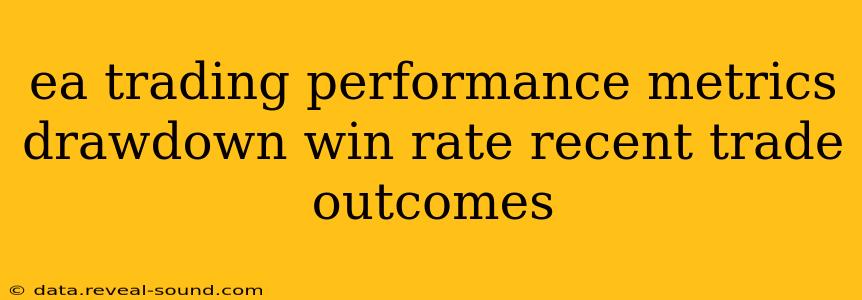Understanding the performance of an Expert Advisor (EA) in forex or other markets requires a deep dive into several key metrics. While backtesting provides a historical perspective, monitoring these metrics in live trading is crucial for ongoing optimization and risk management. This article will explore the most important performance metrics, focusing on drawdown, win rate, and recent trade outcomes, and how to interpret them effectively.
What is Drawdown in EA Trading?
Drawdown represents the peak-to-trough decline in an EA's equity curve during a specific period. It essentially shows the maximum percentage loss from a peak high to a subsequent low. A large drawdown indicates significant risk and potential for substantial losses. Understanding drawdown is crucial because it reflects the robustness of your EA's strategy under adverse market conditions. A high drawdown might signal flaws in the EA's risk management or an overreliance on specific market conditions that may not always persist.
How to Interpret Drawdown
The acceptable level of drawdown depends entirely on your risk tolerance. Some traders may tolerate drawdowns of 10%, while others might prefer to keep them under 5% or even lower. The key is to establish a threshold before deploying the EA and to closely monitor its drawdown during live trading. A sudden and sharp increase in drawdown should trigger a review of the EA's parameters and potentially a temporary suspension of trading until adjustments are made.
Win Rate: The Percentage of Winning Trades
The win rate is simply the percentage of trades that result in profit. A high win rate is often desirable, but it's not the sole indicator of a successful EA. A high win rate coupled with small profits and large losses can still lead to significant overall losses. Conversely, a lower win rate with large winning trades and small losing trades can be extremely profitable.
Win Rate vs. Risk-Reward Ratio
The win rate should be considered alongside the risk-reward ratio. The risk-reward ratio is the relationship between the potential profit of a trade and the potential loss. For example, a 1:2 risk-reward ratio means that for every $1 risked, the potential profit is $2. Even a low win rate can be profitable if the risk-reward ratio is sufficiently high. Therefore, analyzing these two metrics together provides a much more comprehensive picture of EA performance than focusing solely on the win rate.
Recent Trade Outcomes: Analyzing Recent Performance
Analyzing recent trade outcomes offers a glimpse into the EA's current performance and adaptation to changing market conditions. While past performance is not indicative of future results, monitoring recent trades helps detect potential issues early. Tracking the frequency of winning and losing trades, average profit/loss per trade, and the overall equity curve in recent weeks or months gives a much more current picture of EA efficacy.
What to Look for in Recent Trades
Look for patterns in winning and losing trades. Are losses clustered, suggesting a potential vulnerability in the EA's strategy? Are profitable trades consistently following specific market conditions or patterns? This analysis can inform further optimization or adjustments to the EA's parameters to improve its overall performance.
Frequently Asked Questions (FAQs)
Q: How often should I monitor my EA's performance metrics?
A: The frequency depends on your trading style and risk tolerance. Daily monitoring is advisable for high-frequency trading strategies, while weekly or even monthly monitoring might suffice for long-term strategies. Regular review allows for timely interventions if necessary.
Q: What should I do if my EA experiences a significant drawdown?
A: A significant drawdown requires immediate attention. Review the EA's recent trades, analyze the market conditions during the drawdown period, and consider adjusting the EA's parameters, such as stop-loss levels or position sizing, or temporarily suspending the EA to assess the situation further.
Q: Can a low win rate EA still be profitable?
A: Absolutely. A low win rate can be profitable if the winning trades significantly outweigh the losses. This is achieved through a favorable risk-reward ratio. Focus on the overall profitability rather than just the win rate alone.
Q: How do I determine an acceptable drawdown level for my EA?
A: The acceptable drawdown level is subjective and depends heavily on your risk tolerance. Start by setting a conservative limit based on your account size and risk management strategy. Regularly monitor the drawdown and adjust your risk tolerance as needed based on performance and experience.
By carefully monitoring these key performance indicators – drawdown, win rate, and recent trade outcomes – you can significantly improve your EA's profitability, enhance your risk management, and increase the likelihood of long-term success. Remember, continuous monitoring and adaptation are crucial for optimal performance in the dynamic world of algorithmic trading.
